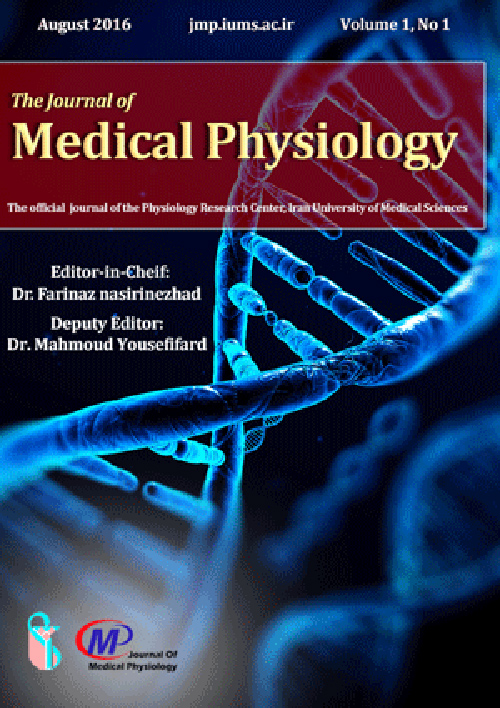فهرست مطالب

Journal of Medical Physiology
Volume:3 Issue: 1, 2018 Spring
- تاریخ انتشار: 1397/02/11
- تعداد عناوین: 5
-
Page 1When an abscess is drained, either spontaneously or surgically , the pathway to the infection remains and is lined with epithelial tissue and leads to the formation of anal fistulas. The treatment of fistulas remains a serious challenge for colorectal surgeons with varying degrees of success because extensive surgery to complete control complex fistulas results in fecal incontinence. One of the most recent non-surgical methods is cell therapy, clinical trials for which are ongoing in the third phase. In this method, stem cells with different sources are used to control inflammation and replace the lost tissue in the fistula tract. Therefore, the purpose of this narrative review is to review cell therapy in treatment of anal fistulas along with its weaknesses and strengths. Finally this review of existing studies for anal fistulas suggests that until now, only two sources of stem cells , in both allogeneic and autologous forms, have been used in clinical trials for treatment of anal fistulas: adipose tissue and bone marrow (mainly adipose tissue) and except for the two Phase III clinical trials in 2012 and 2016, all clinical trials in this field were conducted in phase one and two with the aim of determining the safety and efficacy of these cells.Keywords: Stem Cells, Cell Therapy, Anal Fistula
-
Page 2Phenylketonuria (PKU) occurs due to a mutation in the gene encoding phenylalanine hydroxylase, which results in inability to convert phenylalanine into tyrosine. DNA methylation is an important epigenetic modification of the genome. Many human diseases have been detected to be related to aberrant DNA methylation. Investigating the leukocytes of PKU patients exposed to phenylalanine has shown a wide range of methylation, which indicates DNA methylation changes as a biochemical marker. In this article, we reviewed evidence of DNA methylation in pathophysiology of PKU.Keywords: DNA methylation, Phenylketonuria, phenylalanine
-
Page 3BackgroundAlthough temperament is considered one of the most important principles of traditional medicine, it has always been one of the challenging issues among experts. Therefore, the present study was planned aiming to determine the importance and validity of temperature and anthropometric factors in determining temperament.MethodsA cross - sectional study was performed on 20 to 25 year old students of Tehran University of Medical Sciences. Initially, using a standard questionnaire temperament of the participants was determined. Then its relationship with central and peripheral temperature, height and weight and body mass index (BMI) was analyzed via correlation test and with the significance level of pResults102 students (45.1% male and 54.9% female) were enrolled. Analyses showed the significant correlation of temperament score with core temperature, and skin temperature at the tip of the index finger, palm and wrist as well as anthropometric factors. Among them, temperature of palms (r=79.0, pConclusionThe findings of the present study showed that palm temperature and sublingual temperature had a strong correlation with temperament and can be considered as the two main indices used for determining temperament.Keywords: Medicine, Traditional, Temperament, Skin temperature, Body Temperature
-
Page 5
esenchymal stem cells (MSCs) are interested to more than other cells and human adipose derived stem cells (hADSCs) more than other types of MSCs due to pluripotency, secretion of different growth factors, high angiogenic factor secretion, high immunity, and fewer ethical problems during In vitro, pre-clinical and clinical studies (1-12) . In the field of regenerative rehabilitation, one of the main goals of the scientists always has been to achieve the best and most efficient type of stem cell. Choosing the appropriate source for extracting these cells is undoubtedly important in achieving the best and most efficient cell. Because fatty tissue in humans is two types of white and brown, the basic question is: hADSCs are extracted from which fat types have the most effective therapeutic action in repair of different tissues? Because fatty brown tissue is metabolically more active than white adipose tissue (13) it may that stem cells extracted from fatty brown tissue are also likely to be more active. The rejection or confirmation of this hypothesis surely is not possible without performimg of in vitro studies to compare the stem cells extracted from brown and white adipose tissue. If this comparison is done, the results of it are a very important point in the extraction and processing of hADSCs. Therefore, it is recommended to design and conduct exact studies to compare stem cells extracted from brown and white adipose tissue.
Keywords: Adipose tissue, Fat, Stem Cell

